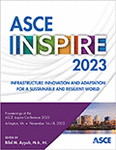Incremental Development Model Using Vacant Buildings for Affordable Housing
Publication: ASCE Inspire 2023
ABSTRACT
Vacant properties have increased and become a problem in cities in the US. Few studies addressed how to utilize vacant properties for affordable housing despite they can be a great resource for affordable housing. To improve affordable housing sustainability, researchers recommended incremental development because it can satisfy residents’ dynamic demands over time and engage them in house design. This can be implemented by utilizing vacant buildings to maximize their potential for affordable housing. Through the literature review, critical sustainability criteria for affordable housing are yielded. This paper demonstrates how the incremental development of vacant buildings satisfies the critical sustainability criteria. A development model and a guideline for site selection are provided to show how vacant buildings should be modified. The incremental development model and the guideline can contribute to the understanding of relevant stakeholders to address vacant properties and affordable housing at the same time. Future studies can leverage the outcomes to develop a detailed framework including an analytic hierarchy process.
Get full access to this article
View all available purchase options and get full access to this chapter.
REFERENCES
Accordino, J., and Johnson, G. T. (2000). “Addressing the Vacant and Abandoned Property Problem.” Journal of Urban Affairs, 22(3), 301–315, https://doi.org/10.1111/0735-2166.00058.
Balemi, N., Füss, R., and Weigand, A. (2021). “COVID-19’s impact on real estate markets: review and outlook.” Financial Markets and Portfolio Management, 35(4), 495–513, https://doi.org/10.1007/s11408-021-00384-6.
Bertino, G., Kisser, J., Zeilinger, J., Langergraber, G., Fischer, T., and Österreicher, D. (2021). “Fundamentals of Building Deconstruction as a Circular Economy Strategy for the Reuse of Construction Materials.” Applied sciences, 11(3), 939, https://doi.org/10.3390/app11030939.
Chan, A. P. C., and Adabre, M. A. (2019). “Bridging the gap between sustainable housing and affordable housing: The required critical success criteria (CSC).” Building and Environment, 151, 112–125, https://doi.org/10.1016/j.buildenv.2019.01.029.
Chohan, A. H., Che-Ani, A. I., Shar, B. K., Awad, J., Jawaid, A., and Tawil, N. M. (2015). “A Model of Housing Quality Determinants (HQD) for Affordable Housing.” Journal of Construction in Developing Countries, 20(1), 117–117.
Chohan, A. H. (2022). “Matrix of Affordable Housing Assessment: A Development Process.” Designs, 6(1), 4, https://doi.org/10.3390/designs6010004.
Dragos, A. (2023). “The National Apartment Size Shrinking as Studios & 1-Bedroom Apartments Gain in Share.” <https://www.rentcafe.com/blog/rental-market/market-snapshots/national-average-apartment-size>(May 5, 2023).
Hoyt, H., and Schuetz, J. (2020). “Parking requirements and foundations are driving up the cost of multifamily housing.” Brookings Institution, Washington, DC, <https://www.brookings.edu/research/parking-requirements-and-foundations-are-driving-up-the-cost-of-multifamily-housing>(May. 1, 2023).
Moghayedi, A., Awuzie, B., Omotayo, T., Le Jeune, K., Massyn, M., Ekpo, C. O., Braune, M., and Byron, P. (2021). “A Critical Success Factor Framework for Implementing Sustainable Innovative and Affordable Housing: A Systematic Review and Bibliometric Analysis.” Buildings, 11(8), 317, https://doi.org/10.3390/buildings11080317.
Mukhija, V. (2014). “The Value of Incremental Development and Design in Affordable Housing.” Cityscape, 16(2), 11–20.
Noterman, E. (2021). “Taking back vacant property.” Urban Geography, 42(8), 1079–1098, https://doi.org/10.1080/02723638.2020.1743519.
Parolek, D. G. (2020). Missing middle housing: Thinking big and building small to respond to today’s housing crisis. Island Press, Washington, DC.
Riazi, M., and Emami, A. (2018). “Residential satisfaction in affordable housing: A mixed method study.” Cities, 82, 1–9, https://doi.org/10.1016/j.cities.2018.04.013.
Schilling, J. M. (2002). The revitalization of vacant properties. ICMA (International City/County Management Association), Washington, DC.
Seo, K. W. (2016). “Incremental SI (structure-infill) Housing for Low-income Population in Malaysia.” Northumbria University, <http://nrl.northumbria.ac.uk/id/eprint/29358>(Apr. 20, 2023).
Sidi, N. S. S. (2011). “Quality Affordable Housing: A Theoretical Framework for Planning and Design of Quality Housing.” Journal of Techno-Social, 2(1).
Tappendorf, J. A., and Denzin, B. O. (2011). “Turning Vacant Properties into Community Assets Through Land Banking.” The Urban Lawyer, 43(3), 801–812.
Vale, L. J., Shamsuddin, S., Gray, A., and Bertumen, K. (2014). “What Affordable Housing Should Afford: Housing for Resilient Cities.” Cityscape, 16(2), 21–50.
Wainer, L., Ndengeingoma, B., and Murray, S. (2016). Incremental Housing and Other Design Principles for Low-Cost Housing. International Growth Center (IGC). London, United Kingdom.
Williams, J. (2021). “Circular cities: what are the benefits of circular development?” Sustainability, 13(10), 5725.
Information & Authors
Information
Published In
History
Published online: Nov 14, 2023
ASCE Technical Topics:
Authors
Metrics & Citations
Metrics
Citations
Download citation
If you have the appropriate software installed, you can download article citation data to the citation manager of your choice. Simply select your manager software from the list below and click Download.
